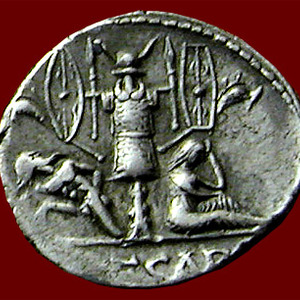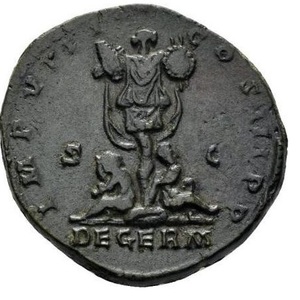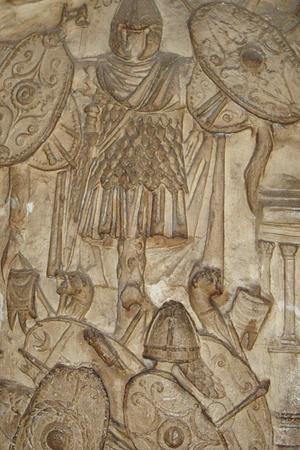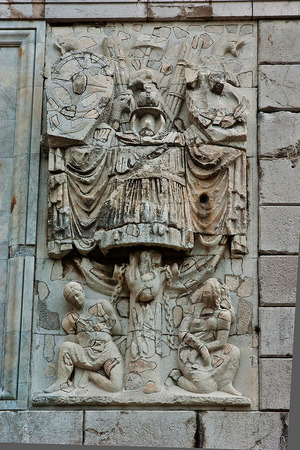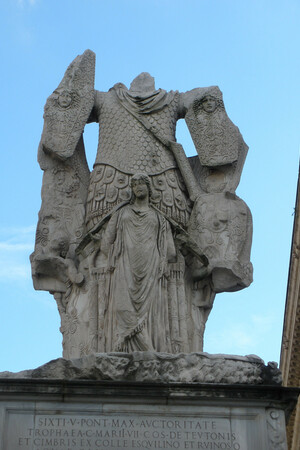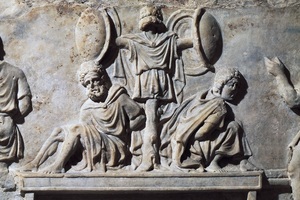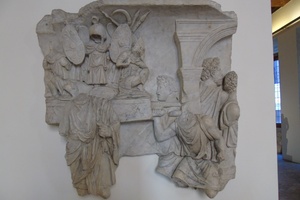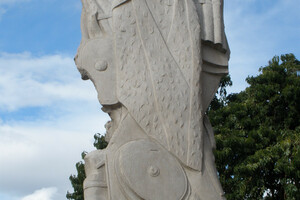Trophy
A trophy, or tropaeum (Latin: tropaeum, trophaeum; Greek: τρόπαιον, from τροπή), is a type of ancient symbolic structure: a trophy monument erected by victors from the equipment of defeated enemies. It was often depicted on military gear and in architecture as one of the symbolic motifs.
The term also took on significant meaning in the architecture and monumental decorative art of Classicism, Neoclassicism, and Empire styles, coming to signify a decorative motif representing sculptural, relief, or painted images of weapons, military armor, and attributes.
Tradition of Erecting a Trophy
Originally, the term "trophy" did not mean "loot," but rather it was a sacred object. It represented a post (or a tree stripped of its branches and bark) on the battlefield, onto which the warriors of Greece and Rome would hang the armor of the defeated enemy after a victory. Typically, this would be the armor and helmet, signifying that victory on the battlefield had been secured by them. The erection of this post had a symbolic, dedicatory character, as evidenced by ancient texts:
"Pious Aeneas, though pressed by the care to bury the fallen and though grief darkened his soul, still hastened at dawn to fulfill his vows to the gods. Heaped a mound and stripped a mighty oak of its branches, He raised a trophy in your honor, Lord of Battles, And adorned it with the armor taken from Mezentius: He hung the shaggy helmet stained with blood's dew, Broken spears and the heavy cuirass pierced in a dozen places; And to the left side of the trunk he securely fastened The bronze shield and the sword in its ivory scabbard." (Virgil, Aeneid, XI, 2-11)
The ritual of erecting a trophy was of great importance. During the war between Sparta and Argos over the city of Thyrea in Laconia, the outcome of the battle was to be decided by a "duel" between two contingents of 300 men from each state. Both armies left a contingent behind and withdrew. The two contingents fought throughout the day, and by nightfall, only three heavily wounded men remained—two Argives and a Spartan named Othryades. None of them had the strength to continue fighting. The two Argives left the battlefield to report their victory. The Spartan, however, remained, and gathering the armor of the slain enemies, hung them on a tree at the edge of the field, writing on a shield with his own blood: "Spartans—Zeus, a gift of victory." By morning, both armies returned, each believing they were the victors. Although a conflict arose and in the ensuing larger battle the Spartans emerged victorious, Othryades' action lent their victory a high moral standing, as it was his deed that claimed the battlefield. Othryades was proclaimed a hero.
Another mention of blood inscription on trophies is found in the account of the Roman victory over the Frankish leader Butilinus, when the river Capua, swollen with corpses, overflowed its banks. On a post erected on its bank, an elegy was inscribed: "O most fortunate river! Instead of a trophy, let it be stained with barbarian blood."
Tacitus mentions that after one of the Roman victories over Germanic tribes during the reign of Emperor Tiberius, a trophy was made from captured weapons, on which were inscribed the names of the defeated tribes.
Greek Trophies
In ancient Greece, the tradition of erecting trophies is known from the archaic period. The monument was placed on an elevated spot and dedicated to the patron deity. A special inscription would mention the names of the victors and the defeated party. After this, the trophies were considered inviolable. Typically, even enemies did not dare to remove them unless the trophies were erected without proper cause.
To prevent conflicts from persisting due to the long-lasting presence of trophies, there may have been a law that required trophies to be made of wood rather than durable materials (stone, metal). In the event of destruction, it was forbidden to repair or restore them. For example, the Macedonians accused the Thebans before the Amphictyonic Council of erecting a metal trophy. Over time, more metallic trophies began to appear. Initially, trophies were placed directly on the battlefield, but since suitable plains for battles were scarce in mountainous Greece, they were often replaced by a new trophy after another battle. Eventually, they began to be erected in Hellenic sanctuaries such as Delphi or Olympia to further glorify the victorious state.
If a victory was achieved at sea, the trophy was erected on the nearest shore to the battle site. Naval trophies were often adorned with ship prows (Greek: άκρωτήρια) and dedicated to Poseidon.
Roman trophies
The Romans initially did not erect trophies, instead taking the spoils of battle (Latin: spolia) back home to decorate public buildings and private residences. However, they later adopted the custom of commemorating victories with trophies from the Greeks. The first Roman trophies were erected by Domitius Ahenobarbus and Fabius Maximus in 121 BC, following their victory over the Allobroges. Pompey erected a trophy in the Pyrenees after his victories in Spain. Caesar did so near Zela after his victory over Pharnaces. Drusus set one up near the Elbe to commemorate the defeat of the Germans. However, the Romans preferred to build commemorative monuments in Rome itself rather than at the battle sites. The most prominent examples of this practice are the triumphal arches, which are essentially trophies as well. In Rome, the Rostra—a speaker’s platform—stood in the Forum, adorned with the prows of ships.
The spolia opima, or "rich spoils," were particularly esteemed. These were a trophy dedicated to Jupiter Feretrius, brought only by a military commander (king or consul) who had personally killed an enemy commander in battle and taken his armor. There were only three such instances in Roman history:
- Romulus defeated the king of the Ceninenses, Acron.
- Aulus Cornelius Cossus, a military tribune with consular power, defeated Tolumnius, the king of Veii, in 437 BC.
- Consul Marcus Claudius Marcellus defeated the king of the Insubres, Virdumarus (Britomartus), in 222 BC.
The mythical description of Aeneas' victory over Mezentius is associated with this tradition.
Many Roman coins have been found, often issued to commemorate a victory, with one side depicting the profile of the general and the other showing a trophy, sometimes alongside sacrificial implements and bound prisoners, or in combination with the goddess of victory, Victoria.
Although a distinct form of building—the tropaeum—emerged in ancient Rome, posts adorned with weapons continued to be erected during the imperial era, as they required much less time to construct and could be mass-produced.
Trophies were also used decoratively, featuring ornamental armor (rather than real captured weapons). In The Antiquities of the Jews, Josephus tells of a conflict in Jerusalem when Herod I established games in honor of Caesar and built a theater decorated in Roman style, specifically with "images of his trophies in gold and silver, taken from the nations he had conquered in war." This offended the Jews, who saw in them prohibited images of armed men and began to shout that they would not allow "idols" in their city. Herod then invited the most influential of the protestors to the theater and, pointing to the trophies, asked what they thought they were. When they replied that they were images of men, he ordered the weapons to be removed and showed them bare wooden posts, which defused the conflict.
Interestingly, in his letter To the Heathen, Tertullian notes that the cross, which he worships as a Christian, is essentially the post of an incomplete pagan Roman trophy, depicted in Christianity without any armor or decorations.
Related topics
Pugio, Gladiators, Legionnaire
Literature
- V. B. Petrunin, A. M. Mikhailov. Hunting in Russia. Hunting Trophies. — Publisher: AST, 2003. — P. 190. ISBN 5-17-016156-5
- Obnorsky N. P. Trophies, among the ancient Greeks // Brockhaus and Efron Encyclopedic Dictionary : in 86 volumes (82 volumes and 4 supplementary). — St. Petersburg, 1890—1907.
- Trophies, in decorative art // Brockhaus and Efron Encyclopedic Dictionary : in 86 volumes (82 volumes and 4 supplementary). — St. Petersburg, 1890—1907.

 Gallery
Gallery






